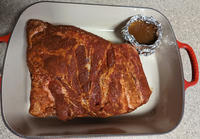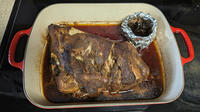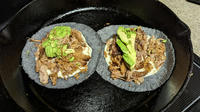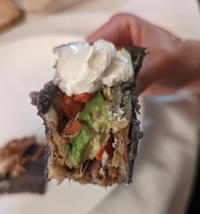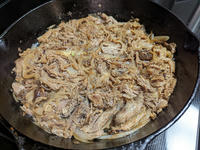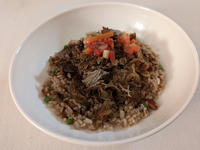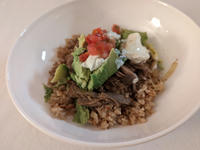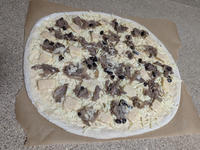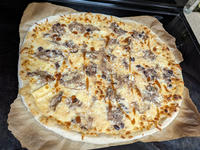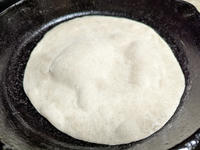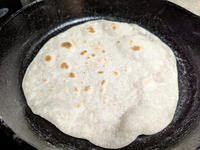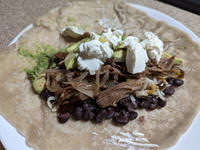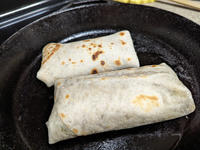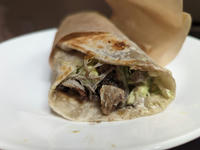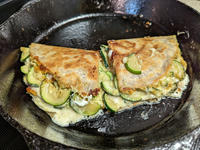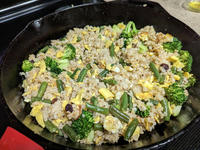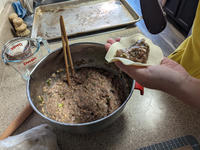Pork Shoulder Roast
Braising🔗
Slow roasted pork shoulder is a gem. It has lasted for a month (with intermittent freezer hibernation) and powered a total of 14 meals for two. This is a Guinness record of how many meals one ingredient can generate. Note that it's the main not the sole ingredient. To make a full meal, there are vegetables and carbs to accompany. Regardless, the cost per meal is astonishingly bargain. Given that protein usually takes the most budget. Plus, high versatility enables a wide range of use cases. Meals differ in flavors and formats that it never gets old. In fact, it's been turned into 6 very different types and more possibilities are still out there. A full tally will be given at the end. Let's first unveil the magic of braising.
This is the first time I've tried tough huge cut low and slow braising. In fact, when considering which baking vessel to use, I suddenly realized we have a proper Le Creuset roasting tray that's never been used for roasting but mainly for baking bread. All I'm trying to say is that I was as nervous and green as anyone who attempted a big roasting project for the first time. The good news after my first go is the discovery of such a great technique. It's mess-free, hands-off, efficient, versatile, bargain, delicious, ... I can keep going on its merits.
The science behind braising tough cut is in short and plain is --
Tough chewy parts melt under certain temperature range after certain amount of time and become tender and juicy.
So, the goal is to get meat into certain temperature range (200-250F) for certain amount of time (8-12hr). It will depend on your oven power, size of the cut, etc. But error margin is fairly generous. If not tender enough just go for more time. If too tender, well, I don't see too much of an issue. One key thing is to create a humid sealed environment. Otherwise evaporation during long oven time will dry out everything. I made two tin foil cups filled with seasoned water (spice mix, liquid smoke etc) and nestled them in the roasting tray. Then cover the tray with another tray of same size inverted to create a sealed chamber. Put the entire thing in the oven overnight.
I've listed the steps below. It's very minimal hands-on time. Basically the very basic prepping for any kind of meat, i.e. clean, dry and season, and that's it. Set up some contraption and go to bed. It's extremely efficient given you are spending an average amount of time prepping for a cut as big as it fits the tray. For reference, we have an 8lb bone-in.
Steps
- Rinse and dry
- Score fat cap
- Rub seasoning
- Minimum: salt & pepper
- BBQ: salt, brown sugar, paprika, garlic powder
- Set aside in fridge for couple of hours until some liquid drawn out
- Fat cap down in roasting pan
- Aluminum cup of water+liquid smoke
- Cover tray with an inverted tray of same size
- 240F, lowest rack, 12hr
- Uncover, cool down in oven till touchable
- Shred meat into bowl, save dripping in another bowl, save bones for broth
The final yield includes:
- 2000g cooked shredded pork
- 48oz gelatin
- 16oz pork fat (after dripping cooled off, pork fat is capped on top)
- bone broth (boil bones in water)
Taco Carnitas x2🔗
I made purple corn tortillas to recreate the SD taco experience. The making of corn tortilla is not hard and kinda fun. However, the mastery of any bread like long history staple food takes practice. The result might differ from those authentic Mexican shops. It's hard to beat warm fresh-out-of-oven bread like stuff. In this case it's a cast-iron pan.
The overall process is fairly quick thanks to the gluten free nature of corn. There is no waiting after mixing dough. Roll, press and cook. For brevity, I will only give the formula and key notes.
Formula for 10, 60g each
- 240g masa
- 360g water (enough to form playdough)
- Some oil
Key notes
- Keep moist with damp towel at any stage
- Press into disk between freezer bag
- Cast iron preheat to 180C
- Flip after 1 min, total 2min
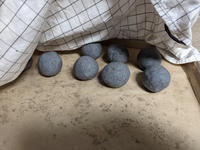
|

|

|
|---|---|---|
| roll into individual dough balls, cover with damp towel | press with pizza steel, ziplock bag two side cut open to prevent sticking | cook in cast-iron |
Corn tortilla is quite fragile thanks to again gluten free nature of corn. That's why it's extra good to have it fresh. Moisture maintains flexibility that would otherwise easily crack when bending. You use corn tortillas like an edible scoop, load up with meat, cheese, salsa, avocado, sour cream etc and have a bit of everything. The more deluxe, the messier. But it's a delicious mess.
Pork over Rice x4🔗
Rice bowl is an unassuming yet ultimate comforting format of meal. Sauté onions with pork fat and mix in shredded pork. Top over rice. Finish with anything fresh, avocado, salsa, cheese etc. So convenient so satisfying so little work.
Piggy Pizza x2🔗
If you have pulled pork on pizza, almost without saying it's BBQ sauce. We have the premium pulled pork topping at hand. How can I let go of the perfect chance of making the classic? Although we have the sauce from our favorite BBQ place BBQ 152, I opted to concoct a homemade version based on the byproduct stock to highlight the original pork flavor (instead of the already known tasty sauce). The result is not the typical sweet savory BBQ but rather subtle soy saucy pork.
Continuing the Asian theme, the second pizza is miso based. The salty umami miso pairs well with pork. What makes it even better is a touch of sweetness to balance out the strong salty and savory-ness. Honey miso is the white BBQ. Use water to dilute miso to runny consistency. Add honey to taste.
Pull Pork Okonomiyaki x1🔗
It's "okonomi", of course we can use pulled pork. Basically the same way to cook as the classic with pork belly or bacon (see technique here).
Udon x3🔗
See New Year Special
Burrito x2🔗
To complete the "better than food truck" series, I set out to make flour tortillas myself. It's a simple 60% hydration warm water dough with just flour, water, salt and a tiny bit of oil. Mix, rest, roll and cook. Pretty much the same as corn tortilla. It's tricky to get pan temperature right for the first one. But once dialed in, it's quite fun to see the tortilla puff up.
The final texture isn't quite the same as food truck, not as soft and pliable. Probably because my version is thicker and has less fat. To be honest, I like food truck tortillas better, more wrapping friendly. But it's still meaningful and worthwhile to make myself. For practice and for love of fresh warm bready stuff.
Wrapping is always the fun part. Just a fun fact, super burrito actually means the addition of sour cream. Traditionally, burrito is just meat, rice, beans and salsa wrapped in tortilla. What makes it super is sour cream, not cheese or avocado. However, special at AnYYwAYY of course has everything. If there is any complaint about homemade tortilla, I wish it could be bigger so more filling could fit without structural breach.
Although it's not the same as food truck, our version is good in a different way. Overall, I'm very proud and pleased.
Derivatives🔗
There are two derivatives from roasting: fat and gelatin. Both are advanced flavor bomb.
Fat ~12oz
- Veggie sauté
- Fried rice
Stock full of gelatin ~48oz
- Juicy filling
